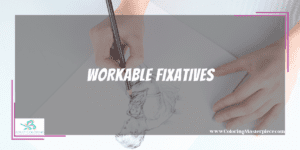We have all experienced that sinking feeling of disappointment after spending hours on a pencil drawing, only to pull the piece out of our portfolio and discover smudges. Don’t worry! Here are tried and true methods to protect your work.
Although there are lots of opinions available on how to prevent pencil drawings from smudging, we detail four highly recommended, common-sense pieces of advice that include:
-
- Choosing instruments and materials carefully
- Using good hand placement
- Attaching appropriate protective barriers between your work and the world
- Using highly recommended workable and final fixatives when necessary
No one wants to have important work ruined. With these simple tips, you won’t have to worry about protecting your work anymore!
Instrument Choice

When choosing which pencil to use, keep in mind some pencils tend to smudge more than others. 6B – HB range pencils leave a darker mark and, therefore, leave more graphite on your paper. H – 6H range pencils leave a lighter mark, leaving less graphite on the paper for smudging.
Choosing a good quality paper also has an impact on smudging. A good quality Bristol board with a kid finish or Canson brand paper is recommended for pencil drawings instead of tracing or typing paper. These high-quality papers clean more quickly, too.
Eraser choice is equally important. Many artists recommend the style of eraser that you hold like a writing utensil and extend more eraser as necessary. These kinds of erasers are especially good for small details.
Kneaded erasers, which are made of a kind of putty-like material, are specially formulated to pick up graphite. Especially helpful because they can be formed into various shapes and sizes to pick up pencil marks in special places, kneaded erasers are a favorite among artists. To ensure your kneaded eraser is always clean and free of any materials that can smudge, store it in a small pencil box or even a baggie when not in use.
Once you use an eraser, you’ll have pesky little eraser bits left over on your paper. Please resist the urge to blow them off your paper. You’d be surprised how many microscopic particles of saliva are ejected in even a small, soft sigh. Moisture of any kind is not a friend to pencil drawings.
Don’t use your hand to brush those eraser bits away, either. Even with that quick movement from your hand, moisture and oils on your skin can smear your pencil drawing, too. Always use a clean, dry makeup or artist’s brush that’s expressly set aside for the sole purpose of brushing away eraser leftovers. You’ll be so glad you did!
Learn more about pencil drawings HERE!
Last, but certainly not least, is the tried and true recommendation of a mahl stick. Used as long as artists have been creating, the mahl stick is approximately two feet long with a soft, padded head on one end, allowing it to rest either on a finished portion of your work or its outside, while your drawing hand rests on the stick itself. This guarantees your drawing hand will not smudge as you go. Although mahl sticks are less popular today, they are incredibly practical and useful when drawing larger pieces.
Hand Placement
When you begin your sketch, think about how you want it to be presented on the page. Then, if you are right-handed, start sketching in the upper left-hand corner of your page. If you’re left-handed, start in the upper right-hand corner of the page. At least in the very beginning, this ensures that your hand will rest on unused portions of the paper. This allows for unencumbered movement all over the paper. Once you are fine-tuning, use a small piece of vellum under your hand to protect your work.
The Best Barrier
Smudging is caused when pencil drawings brush against another object, causing the graphite on the art to move, typically producing smudges. Therefore, it stands to reason that creating a barrier of protection between the drawing and anything that could touch it is an excellent way to protect your work.
An easy and inexpensive way to protect against smudging is to use a small piece of artist’s tape to secure the plain wax paper you can buy at the grocery store over your piece. This is an easy but mostly temporary fix. In the short term, this barrier is cheap and easy. However, to truly protect your work, all four corners of the protective paper must be secured. This makes showing your work problematic, and it can look unprofessional.
Some advocate for using the commonly found, malleable, single-sheet plastic sleeve protectors that can be purchased anywhere school supplies are sold. These plastic sheets do create a necessary barrier. They also aid in organizing your work within a portfolio. However, depending on your art’s size, sometimes it can be not easy to find sheeting in the appropriate size. Also, because the sheeting is so flimsy, artwork can slide inside the sheeting itself, causing minimal (but still irritating) smudging.
If you plan to use sheeting, most artists recommend using plastic sheeting with PVC. The PVC provides more stability and allows for less moving or crinkling inside a portfolio. This type of PVC sheeting can be purchased from most art supply stores in a multitude of sizes. While more expensive than the plastic page protectors, the sheeting with PVC is well worth the money.
No matter your barrier choice, store your work flat. If stored vertically, it’s likely that your piece will slide, causing the piece to fold in on itself or winkle its edges. Even if you have placed your work in your portfolio, make sure your portfolio can be stored flat when it’s not in use. Better to be safe than sorry!
Workable Fixatives

Workable fixatives are precisely what their name implies. They fix an artist’s work, protecting against smudging; however, they still allow for continued edits or layering of your sketch.
Workable fixatives are overwhelmingly recommended by artists to prevent smudging, but not all fixatives are created equal. Inexpensive fixatives will not produce a quality result. Among the top brands, you should expect to pay between $6.00 – $12.00 per aerosol can.
Applying fixative correctly will impact your final result. To correctly use fixative, it is suggested that artists:
-
-
- Go outside to apply fixative and guard against its strong odor.
- Shake the can thoroughly for approximately two minutes.
- Test spray on a scratch piece of paper to be assured no clumps are present.
- Apply fixative in either a horizontal or vertical motion.
- Stand approximately 18-24 inches away, overlapping spray about ½ inch.
- Let the fixative dry entirely before resuming work. (Approx. 10 minutes)
-
Many artists use fixative before the piece is finished to “fix” one section of their drawing while continuing work on another. Gently tape a piece of vellum over any unfinished work before spraying so that the section is protected.
Final Fixative
Common sense tells you that this fixative is the final step in the life of protecting your piece. Artists should only use this fixative when they are entirely sure the work is finished and either ready to be stored or showcased. After the final fixative is applied, there is no going back! It is important to note that using fixative to your drawing will make the picture appear a little darker in color. The more fixative you apply, the darker the drawing will become.
Small but deliberate choices make a significant impact on your finished work. Try using several methods to protect your work: spray finished pieces with final fixative and place them inside a PVC sheeting for storage inside your portfolio. Or, if you prefer not to use a final fixative, attach wax paper or vellum to all four corners of your finished product before putting it inside your sheeting. You don’t have to pick only one avenue of protection – double up!
Remember, you get what you pay for. If you are still unsure about certain aspects of your piece, consult a trusted salesperson at your local art supply store. Typically artists themselves, useful contacts at a supply store, will provide best practices, recommend quality products, and answer questions relying on their experience and expertise.
Frequently Asked Questions
Should I use hairspray as a possible fixative?
Never use hairspray as a workable fixative. While some claim it is a workable alternative to the higher-priced fixatives, hairspray is difficult to evenly and adequately spray, and it yellows over time, ruining the longevity of your work.
How can I transport my pieces safely inside a portfolio?
Choosing a high-quality portfolio suited to your medium is the first important step in the safe delivery of your work. Ensure your work is protected inside a PVC sheeting and unable to slip and slide inside your portfolio.
What if my smudge won’t erase?
If you’ve tried everything and you still can’t remove the smudge from your drawing, don’t panic. Try working the smudge into your picture. Think through a shading technique or blend it into another part of the drawing. Sometimes little accidents produce quality results!
Love drawing as much as I do? Click here to download my free adult coloring eBook and sign up for my email newsletter!
Disclaimer: The information provided by ColoringMasterpiece.com (“The Site”) is for general informational purposes only. All information on the Site is provided in good faith, however, we make no representation or warranty of any kind, express or implied, regarding the accuracy, adequacy, validity, reliability, availability, or completeness of any information on the Site. Under no circumstance shall we have any liability to you for any loss or damage of any kind incurred as a result of the use of the Site or Reliance on any information provided on the Site. Your use of the Site and your reliance on any information on the Site is solely at your own risk. This blog post is for educational purposes only and does not constitute legal advice. Please consult a legal expert to address your specific needs.
Terms and Conditions: https://coloringmasterpiece.com/terms-and-conditions/
